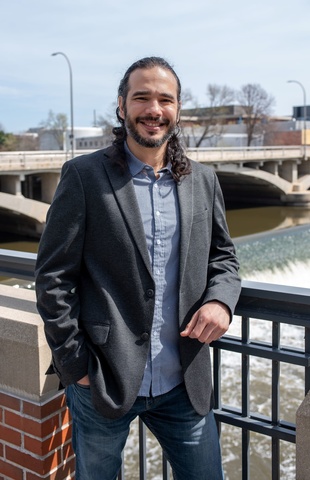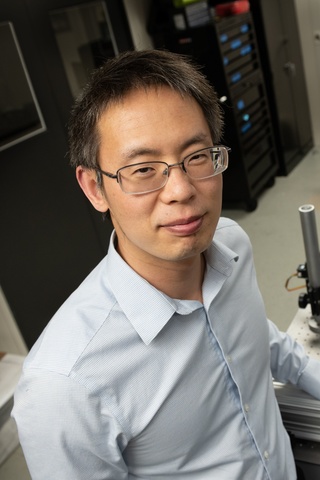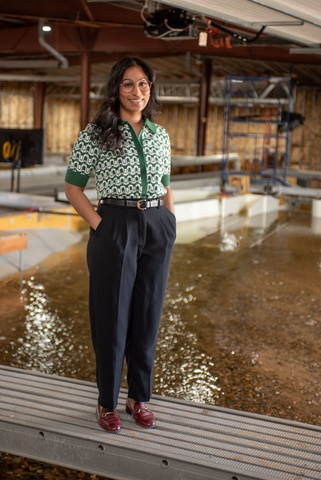Neither rain nor storm nor global pandemic could stop these three new faculty researchers from joining IIHR and the University of Iowa College of Engineering. It is our pleasure to introduce them to you here!
Humberto Vergara
Title: Assistant professor of civil and environmental engineering and IIHR assistant faculty research engineer
Research interests: Hydrology, numerical and hydrologic modeling, flood forecasting

As a child growing up in Colombia, Humberto Vergara dreamed of becoming a scientist and an inventor. Now, remembering his boyhood ambition, he says, “I do feel like that dream came true.”
He followed in the footsteps of his father, an engineer, and earned a BS degree in environmental engineering at El Bosque University in Colombia. He came to the United States and the University of Oklahoma for MSc and PhD degrees in civil engineering, with a focus in water resources.
He stayed on at the University of Oklahoma as a research scientist. He was also affiliated with NOAA’s National Laboratory for Research and the National Severe Storm Laboratory. In this role, he was one of the main developers of a flash flood forecasting system that the National Weather Service (NWS) now uses in daily operations. “A lot of my work has been around early warning applications and, in particular, flash flood forecasting,” Vergara says.
Predicting flash floods is challenging because these events happen so fast, Vergara says. Also, there are essentially no observations to guide the development of hydrologic modeling and improved tools. “You have to be creative and clever,” he explains.
Vergara is thrilled that his forecasting system is making a difference. “We all dream of seeing our research being used to solve real-life problems,” he says. “Now I’m looking forward to the next opportunity.”
For Vergara, that opportunity is in West Africa. He’s part of a team working with NASA to develop a similar flood forecasting system there.
“I am very passionate about this work,” Vergara says. “It’s going to be used to prevent loss of life and losses in property. What I’m doing — it’s very important for society.”
When asked how he ended up at Iowa, Vergara says that when he saw a position open at the College of Engineering and the Iowa Flood Center, he jumped at the chance. “It was a no-brainer,” he says. “I had to apply.”
He and his family — wife Diana, also an environmental engineer, and three children ages 9, 11, and 13 — are enjoying Iowa City and settling in well. The kids relished the chance to play in real snow, although Vergara was less enthusiastic about shoveling it.
He’s happier about the opportunity to play basketball at noon with his colleagues (including IFC director Witold Krajewski). “It’s a great way for me to disconnect in the middle of the week,” Vergara says. As a musician who plays guitar and piano, he’s also finding opportunities to perform.
“That also fills my heart,” he says.
Cong Wang
Title: Assistant professor of mechanical engineering and IIHR assistant faculty research engineer
Research interests: Fluid dynamics, turbulent flow, and drag

If you ask Cong Wang where home is, you’ll get a complicated answer. Born in northern China, he went to Singapore as an undergraduate, where he earned a BEng degree in engineering science. He came to the United States and the California Institute of Technology for graduate school and earned MS and PhD degrees in aeronautics. He stayed on at Caltech for a postdoc and then as a research scientist — 10 years in all.
“The question of where my home is — it’s very difficult, because every place, including Iowa — I love them,” Wang says. “I love my life here. I love Los Angeles and I love Singapore, and of course, my parents are still in China.”
He and his wife Shanshan have two children (ages 4 and 1 1/2), who are also loving life in Iowa City. Wang enjoys taking his kids outside to experience nature as he did as a boy.
Growing up in China, Wang was fascinated by insects, birds, and fish. “Even now as an engineering scientist … I still think that’s a great resource for my research work,” he says. “Birds know how to control their feathers, their wings, and they can manipulate the flow.” Even compared to state-of-the-art technology, Wang says, nature often does it better.
He’s excited by the emerging field of bio-inspired engineering — essentially, learning from the natural world. “Mother Nature has already developed very dedicated flow control devices,” Wang says. “The fish, the birds — they know how to deal with very complex flow motion.”
He adds, “We can learn from the natural world … and based on that knowledge, we can design some new devices and systems, all to achieve better performance.”
How did he happen to end up at IIHR? Hunter Rouse and Fred Stern both played a role in bringing Wang to Iowa.
As a graduate student, Wang says, he watched former IIHR director Hunter Rouse’s film series on fluid mechanics. “It was very inspiring and concise,” he remembers. Each film included a credit to IIHR. That stuck with Wang. Later, as a researcher focusing on naval hydrodynamics, he met many excellent scholars from the University of Iowa, including Professor Fred Stern and others.
“The University of Iowa is very strong in my field of naval hydrodynamics,” Wang says. “I’m very grateful that I can come here and work together with these excellent scholars.”
Wang’s work focuses on fluid dynamics — experimental work and theoretical analysis of turbulent flow, which can cause a huge energy loss for ships and other vehicles. He hopes to develop devices that will allow researchers to achieve better turbulence control.
Wang knows it will take time to solve such fundamental problems. “I think doing research is maybe 95% failure. Most of the time it doesn’t work,” he says. But when it does, that’s the payback. “That kind of ah-ha moment — it’s very rewarding,” Wang says.
Priscilla Williams
Title: Assistant professor of civil and environmental engineering and IIHR assistant faculty research engineer
Research interests: River hydraulics, sediment transport, and physical modeling

Many engineers say they started taking things apart and putting them back together (or trying to) at a very young age.
For Priscilla Williams, it was a little different. “I was told that I should be an engineer,” she says. As a high school student, Williams thought she would follow in her older sister’s footsteps by studying biology and education. “I thought, ‘I’ll just do what she’s doing,’” Williams remembers.
Big sister had another opinion. “She told me, ‘Just do engineering.’”
Williams wasn’t sure she could do it, but with encouragement from her sister and her physics teacher (Williams was a whiz at math and science), she decided to give engineering a try.
Williams went to the University of Windsor in Windsor, Ontario, Canada, where she earned an undergraduate degree in civil engineering with a focus on structures. Along the way, she took a hydraulics course and absolutely loved it. A professor suggested that she pursue graduate school in hydraulics, and Williams decided to go for it. Eventually, she earned a master’s degree and a PhD.
Anyone studying hydraulics is aware of IIHR, Williams says. “Obviously, Iowa’s on your radar.” She was about to move to Vancouver when she saw a job posting at IIHR. “It was right up my alley in physical modeling with sediment transport,” Williams says. She applied, interviewed, and moved to Iowa City a month later.
Williams’ postdoc was spent working with IIHR associate director Troy Lyons and director Larry Weber on a large physical modeling project designed to help trout pass the Freeman Diversion on California’s Santa Clara River.
The 1:24 model of the river was a huge lift for the entire physical modeling group. On March 31, 2023, the shop team put the final touches on the model just before noon.
“At that point, I had been working on it for a year and a half of my life,” Williams remembers. Just before 5 p.m. that afternoon, a tornado hit the building and destroyed the model. Fortunately, no one was hurt, but it was a devastating loss.
“I’m really glad I got the opportunity to work on that model,” Williams says. “It was a really great experience.”
After her postdoc, Williams was hired for a faculty position in civil and environmental engineering, and she continues her research at IIHR. The transition from postdoc to faculty member is a steep one, Williams says. “I still feel like I’m just getting started. The past five months have gone by really quickly.”
She likes teaching and sharing some of the lessons she learned with her students. She’s currently teaching Principles of Hydraulics and Hydrology. “I love that course because it’s their first taste of hydraulics and hydrology,” Williams says.
For her, the transformative lesson was about the Froude number. “My professor used the illustration of throwing a pebble in a river. This was in 2011, and I still remember that. I use that now, and it’s my favorite lesson to teach.”
Outside of work, Williams enjoys playing pick-up soccer with colleagues. She also loves to read — physical books, not on a screen.
Looking back, Williams says she got good advice at every crucial juncture in her career, starting with the big sister who steered her toward engineering.